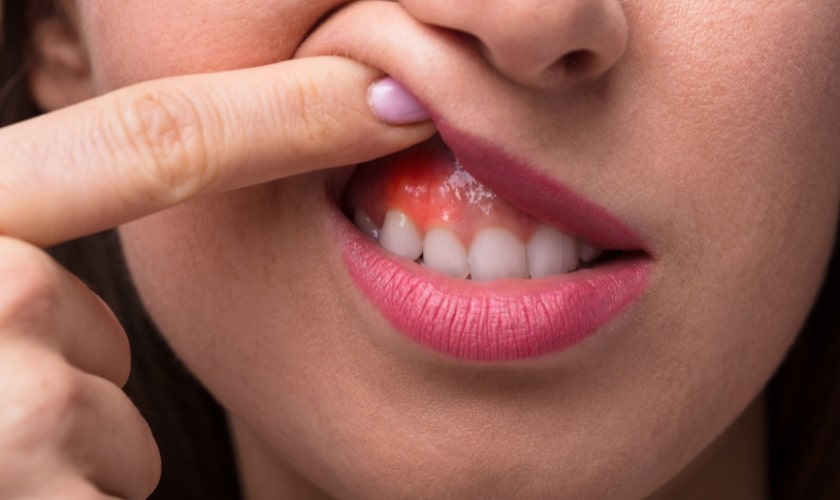Do You Have Gum Disease? 5 Warning Signs
By :
Affordable Dentist | November 24, 2023
Your smile speaks volumes about your health, and your gums play a crucial role in maintaining that radiant grin. However, beneath the surface, a silent threat might be lurking – gum disease. Often underestimated and overlooked, gum disease can lead to severe complications if left untreated. In this comprehensive guide, we will explore the subtle warning signs your gums might be sending you and delve into effective gum disease treatment in Grand Prairie.
The Silent Saboteur: Understanding Gum Disease
Gum disease, also known as periodontal disease, is an infection of the tissues that surround and support your teeth. It typically starts with the accumulation of plaque – a sticky film of bacteria – on your teeth. If not removed through regular brushing and flossing, this plaque can harden into tartar, leading to inflammation of the gums. As it progresses, it can affect the bones that support your teeth, causing them to become loose or even fall out. The early stages of gum disease are often painless, which is why many people may not be aware of the issue until it reaches an advanced stage.
5 Warning Signs of Gum Disease
Bleeding Gums
One of the most noticeable and often the earliest signs of gum disease is bleeding gums, particularly during brushing or flossing. Healthy gums should not bleed easily, so if you observe blood on your toothbrush or floss, it could be a red flag. The bleeding occurs due to inflammation caused by the buildup of plaque, a sticky film of bacteria that forms on the teeth. Ignoring this warning sign may allow the disease to progress, leading to more severe consequences.
Persistent Bad Breath
While bad breath, or halitosis, can have various causes, chronic and persistent bad breath might be an indicator of gum disease. The bacteria that thrive in the infected gums release toxins, contributing to an unpleasant odor. Unlike temporary bad breath caused by certain foods, persistent halitosis that persists even after maintaining good oral hygiene is a cause for concern.
Receding Gums
Gum recession occurs when the margin of the gum tissue that surrounds the teeth pulls away, exposing more of the tooth or its root. This is a common characteristic of advanced gum disease. As the disease progresses, the supporting structures of the teeth weaken, leading to a noticeable change in the appearance of the gums.
Swollen or Red Gums
Healthy gums should have a pink and firm appearance. In contrast, gums that are swollen, red, or tender may be signaling inflammation – a key component of gum disease. Inflammation is the body's natural response to infection, and when it occurs in the gums, it's often a sign that the immune system is actively fighting off harmful bacteria.
Pain or Discomfort While Chewing
As gum disease advances, it can lead to the formation of pockets between the teeth and gums. These pockets become a breeding ground for bacteria, contributing to pain or discomfort, particularly while chewing. If you experience pain or sensitivity in your gums, especially when eating, it's essential to seek prompt dental advice.
Gum Disease Treatment: Taking Action
The good news is that gum disease is treatable, especially when caught in its early stages. Here are some effective treatment options:
Professional Dental Cleaning: Regular dental cleanings by a dental hygienist can remove plaque and tartar buildup, preventing the progression of gum disease. Professional cleanings also help in maintaining optimal oral health.
Improved Oral Hygiene Practices: Consistent and thorough oral hygiene practices, including brushing, flossing, and using an antiseptic mouthwash, are crucial for preventing and managing gum disease. Your dentist can guide you through the proper techniques and products.
Scaling and Root Planing: For more advanced cases of gum disease, a deep cleaning procedure called scaling and root planing may be recommended. This involves removing tartar from above and below the gumline and smoothing out rough spots on the tooth roots to prevent bacterial buildup.
Antibiotics: In some cases, your dentist may prescribe antibiotics to control the infection and promote healing. This can be in the form of topical gels, oral medications, or, in severe cases, as part of scaling and root planing.
Lifestyle Changes: Certain lifestyle factors, such as smoking and poor dietary habits, can contribute to gum disease. Quitting smoking, adopting a balanced diet, and managing stress can significantly improve your gum health.
Your gums are the guardians of your smile, and paying attention to their signals is crucial for maintaining optimal oral health. From bleeding gums to persistent bad breath, these warning signs should not be ignored. If you suspect you might have gum disease, consult with your dentist promptly to discuss a tailored treatment plan. Remember, prevention is key. Adopting good oral hygiene practices, attending regular dental check-ups, and being mindful of the warning signs can help you avoid the complications of it. Your smile deserves the best care.


